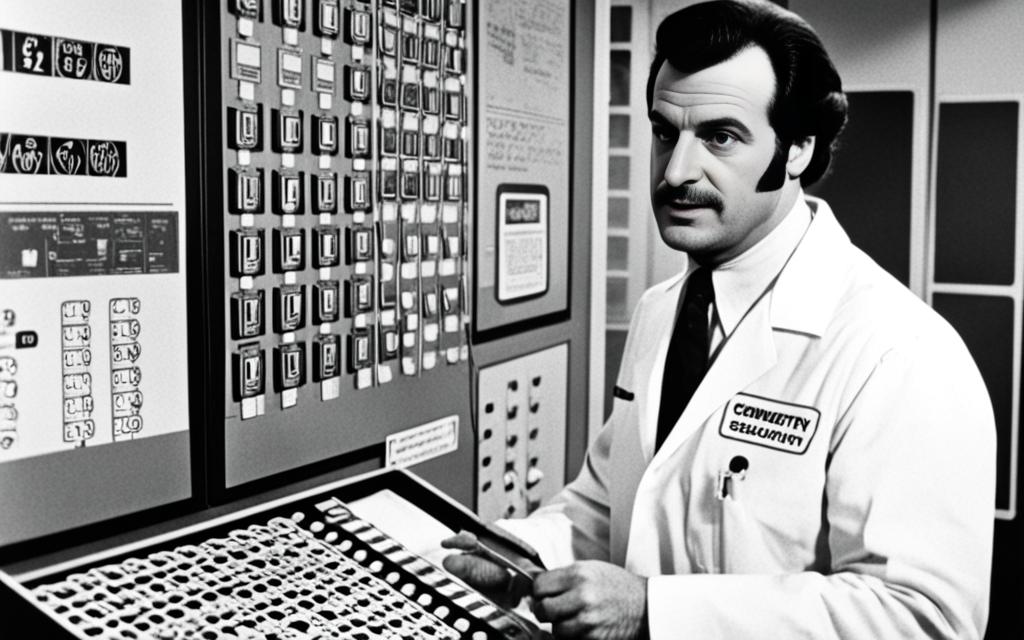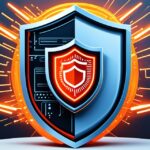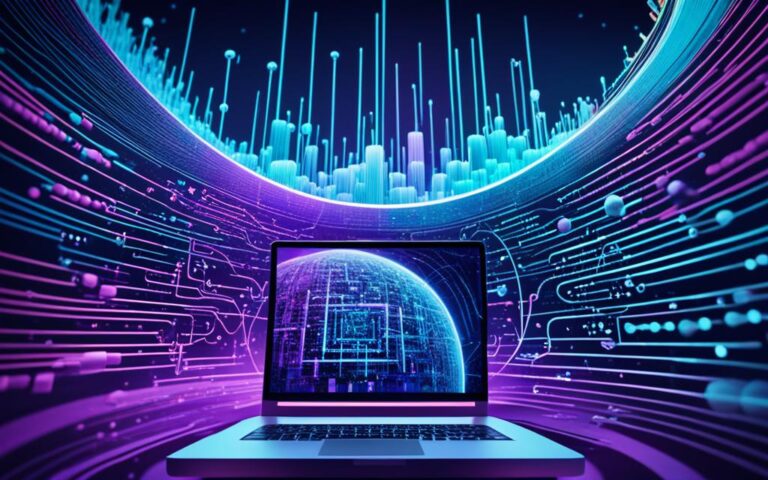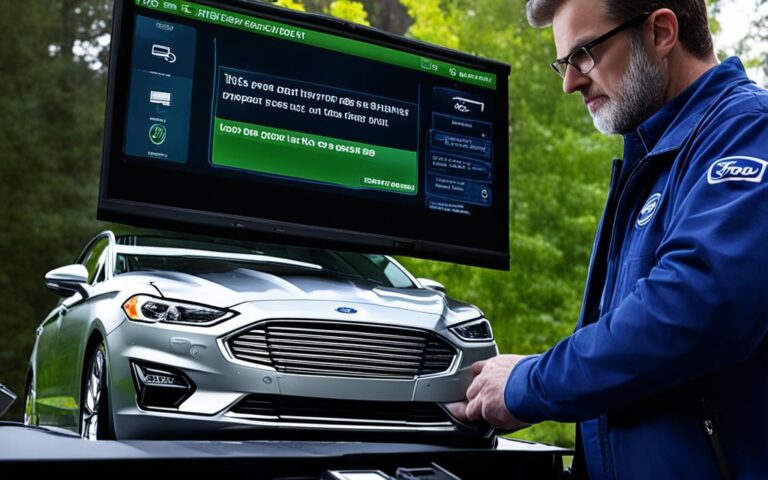Computer security has grown a lot over the last 50 years, becoming today’s information security. Technology’s growth has made protecting information a big deal. Companies like Yahoo, Microsoft, and Equifax have faced hacker attacks. Despite this, cyber safety has gotten better. But, attacks like the WannaCry ransomworm in 2017 show we still need strong antivirus software. This part will look at key moments and progress in info security and hacking.
Key Takeaways:
- 1The 1960s saw the introduction of password protection as a security measure for computers.
- 1In the 1970s, the first computer worm was developed through the CREEPER and Reaper programs, and the first antivirus software was invented.
- 2In the 1980s, cybercrimes increased significantly, leading to the birth of commercial antivirus software and an increase in cyber threat awareness.
- 2The 1990s witnessed the rise of firewalls due to the increased exposure of personal information online and the subsequent increase in network security threats.
- 2In the early 2000s, governments began imposing more serious penalties for hacking activities, moving from light sentences in the 1980s to extensive jail time and large fines.
- 1The 2010s marked a period of major data breaches, highlighting the evolving complexity of cyber threats.
- 2Today, information security is a critical concern due to advancements in technology, posing increased security threats.
- 2The continuous improvement in information security is reflected in the development of novel attack mitigation options by numerous companies.
- 3The history of computer security can be traced back to the 1940s, with the development of digital computers.
- 3Throughout the years, hacking and cyber attacks have evolved, highlighting the need for defensive security measures.
Stay tuned for the next sections as we dive deeper into the milestones and significant developments in computer security throughout history.
Password protection in the 1960s
In the 1960s, companies started using passwords to keep their computers and data safe4. The internet and network connections were not common back then. So, they focused on keeping people out and making sure data was safe from fires4.
Passwords were added to stop people who shouldn’t get in4. They also made sure data was safe from fires since there was no cloud storage4. Passwords first came from research and schools before being used in real life4.
As computers got more popular, hackers started to get better at what they do4. This made people look for better ways to keep things safe, like new ways to check who you are4. Now, we have ways to log in without passwords, making things even safer4.
Over time, keeping things safe with passwords has become key to protecting our digital world4. Companies are always finding new ways to stay ahead of the bad guys4.
From Creeper to Reaper in the 1970s
In the 1970s, ARPANET changed computer networking and set the stage for today’s cybersecurity5. It was here that the first computer worm, Creeper, appeared in 19715. Bob Thomas, a computer programmer, created it. Creeper was more of a test than a threat, sending messages between computers6. This event was a key moment in cybersecurity history, showing how networks could be vulnerable.
After Creeper, Ray Tomlinson made the first antivirus software, Reaper, in 19725. Reaper not only fought the Creeper but also showed a big leap forward. It spread through the network, deleting the Creeper as it went6. This showed how important it was to protect computers from bad software and to act early against cyber threats.
Creeper and Reaper made people aware of network security risks7. They were more about learning than causing harm, but they showed the start of malware’s evolution7. They warned us about the dangers of not securing computers and the interest in hacking them7. The 1970s were a key time for understanding the need for cybersecurity and facing new threats.
The story of Creeper and Reaper on ARPANET started a long journey in cybersecurity5. It showed how important it is to keep up with new threats and to innovate in defense5. From Creeper to Reaper, we see how cybersecurity has changed and how it’s vital for our connected world5.
| Key Points | Statistical Data References |
|---|---|
| The 1970s saw ARPANET start, laying the groundwork for today’s computer networking and cybersecurity | 5 |
| The first computer worm, Creeper, was made in 1971, sending messages between computers | 56, |
| Reaper, the response to Creeper, copied itself and deleted the original, improving its abilities | 56, |
| Creeper and Reaper showed early network security weaknesses and the start of malware | 7 |
| These early programs marked a key time in recognizing cybersecurity threats | 7 |
| The move from Creeper to Reaper highlights the changing cybersecurity landscape and the need for ongoing innovation | 5 |
The rise of firewalls in the 1990s
The 1990s saw the internet grow, connecting the world like never before. This growth brought new challenges, like keeping personal information safe from cyber threats. Firewalls and antivirus programs became key in protecting people and businesses.
At the start, packet filtering firewalls were the first defense against cyber threats8. They checked data packets against set rules, looking at IP addresses and port numbers8. Even though they offered some protection, they couldn’t keep up with new threats.
By the early 2000s, stateful firewalls changed the game8. These could track network connections, making them better at deciding on traffic8. They used state tables and looked at previous packets to stop unauthorized access and understand traffic better8.
As the internet grew, so did the need for better security. Application firewalls joined forces with UTM systems to meet these needs8. UTM systems combined firewalls with antivirus, intrusion detection, and more, offering total security8.
Next-generation firewalls (NGFWs) started in 2008, changing network security again8. NGFWs could deeply inspect traffic, prevent intrusions, and see all applications on the network8. They could also control security based on users, apps, and content8.
NGFWs could also check encrypted traffic, which became more common8. This let them find and block threats hidden in encrypted data8.
Firewall technology has evolved a lot, balancing security with performance8. With more cloud use, cloud-based firewalls are now key for protecting cloud data9. They keep cloud apps and data safe, ensuring they’re private, whole, and available9.
Firewalls have been vital in keeping personal info and networks safe from cyber threats89. From simple packet filters to advanced NGFWs, firewall tech has played a big part in securing our connected world89.
| Firewall Generation | Key Features |
|---|---|
| Packet Filtering Firewalls8 | Inspected data packets based on predefined rules |
| Stateful Firewalls8 | Monitored the state of active connections for better network traffic decisions |
| Application Firewalls8 | Integrated into UTM systems, combining multiple security capabilities |
| Next-Generation Firewalls (NGFWs)8 | Provided deeper inspection, integrated IPS, full-stack visibility, and application-based security policy enforcement |
| Cloud-Based Firewalls9 | Designed to protect cloud-based applications and data |
Proper punishment in the early 2000s
In the early 2000s, governments saw the threat of hacking and cybercrime growing. They made laws and penalties stricter to fight these digital crimes. This was because cybercrimes were getting worse and needed strong punishments to stop hackers.
Sentences for cybercrimes got much harsher, showing a big change from before. Light punishments were replaced with big fines and long prison times. Governments wanted to show hackers that they wouldn’t be ignored.
This tougher approach marked a key moment in fighting hacking and cybercrime. Hackers faced the threat of decades in prison, which stopped many from hacking. Governments aimed to protect important information and keep digital systems safe.
By 2010, long prison terms became a real threat for cybercriminals. This made people think twice before hacking. Government rules made it clear that hacking was illegal and serious.
Along with harsh punishments, governments worked on making cybersecurity better. They used data encryption to keep information safe. Encryption became key in the 2010s for protecting data online.
Encryption like the Data Encryption Standard (DES) helped keep data safe. DES was supported by the NSA and became widely used. It was replaced in 2001 by newer encryption methods, showing how technology keeps changing10.
The rise in cybercrime made governments focus on improving cybersecurity skills. They worked on catching malware early. The 2020s showed how important it is to stay ahead of new threats and adapt to them quickly.
Examples of Noteworthy Cybercrimes:
“The 414s,” a group of teens, stole over $70 million from U.S. banks in the 1980s. This showed how hacking could cause huge financial losses. It made people realize the need for better cybersecurity.
Ransomware attacks became a big problem in the early 2000s. These attacks encrypt data and demand payment to unlock it. Now, a new type of ransomware, called “double extortion,” demands payment twice, making things worse for victims11.
Public organizations were often targeted by hackers because they are open and have a lot of information. Cities and important infrastructure faced big ransomware attacks, like in Atlanta in 2018 and the Colonial Pipeline in 2021. These attacks showed how vulnerable public systems can be and the need for strong cybersecurity.
The COVID-19 pandemic in 2020 made cybersecurity even more important as more activities moved online. Phishing and other cyber attacks went up, taking advantage of the shift to digital work and learning11.
The early 2000s changed how we deal with hacking and cybercrime, with tougher laws and punishments. These efforts were backed by better cybersecurity, improving in malware detection, and recognizing encryption as key to protecting information. The fight against hacking and cybercrime is ongoing, needing constant attention and flexibility to keep us safe.
References:
1. Link 1 – “The Evolution of Information Security”
2. Link 2 – “Emerging Cyber Threats and Trends”
3. Link 3 – “Cybersecurity Milestones and Advances”
The era of major breaches in the 2010s
The 2010s saw major data breaches that changed the cybersecurity scene. These breaches showed us how vulnerable our digital world is. They made us all wake up and take steps to keep our data safe.
Edward Snowden’s whistleblowing
In 2013, Edward Snowden revealed a huge government surveillance network. His leaks showed us how much our privacy was being watched. This sparked a big debate on privacy and cybersecurity’s role in our lives12.
Yahoo’s massive breach
Yahoo faced a huge data breach in 2013 and 2014, affecting billions of users. The breach was only discovered in 2016. It included names, emails, phone numbers, and passwords. This event showed us the dangers of poor cybersecurity and the need for strong protection12.
The WannaCry ransomworm attack
The WannaCry attack in 2017 hit hundreds of thousands of computers worldwide. It affected healthcare and government systems. The attack used a Windows vulnerability, showing the need for quick updates and good cyber habits. This event made cybersecurity a big concern for everyone13.
Enhancing information security
These big breaches made us realize how important strong security is. Companies started using new tools like Network Behavioral Analysis and Denial of Service protection. These steps help keep networks and data safe13.
It’s crucial to stay alert to cyber threats. By being informed and using the latest tech, we can keep our digital world safe. The 2010s taught us a lot about cybersecurity and its importance in our connected world12.
Importance of personal information security
Personal information is a valuable asset that needs strong protection in today’s digital world. Cyber threats are becoming more common, making it vital to have good data protection and proactive strategies. As we use technology more in our daily lives and online, it’s key to know how to keep our data safe.
Document scanning is a big part of keeping personal information secure. By turning physical documents into digital ones, we make them less likely to be stolen, lost, or damaged. This method makes it easier to access, store, and manage important papers while reducing risks. Using document scanning helps keep personal info safe from unauthorized access and makes sure important documents are always available.
Using cloud-based storage is also a smart way to protect personal and business data. These platforms use top-notch encryption to keep sensitive info safe. They have secure ways to send data and strong checks to make sure only the right people can see it. By picking trusted cloud storage, people and businesses can keep their data safe, lower the chance of data breaches, and keep personal information private and whole.
Protecting data is very important because a data breach can cause big problems. Losing or getting unauthorized access to personal info can lead to financial loss, identity theft, damage to reputation, and legal issues. With new tech, cyber threats are getting more common. So, it’s important for people and businesses to be careful and take steps to protect their personal information from threats.
“The average terminal must have an uptime of at least 99.98 percent, with downtime limited to less than 10 minutes per month to ensure availability.”14
Having strong security policies and practices is key to keeping data safe. Companies need to know what kind of security they need for their apps and systems. This means using security tools like firewalls, keeping software updated, and setting up secure networks. Teaching employees and users about how to keep personal information safe also helps a lot in protecting data.
It’s important to know about the different cyber threats out there. Things like malware, phishing, ransomware, and viruses are common threats. Knowing about these threats helps people and businesses take steps to stop and deal with attacks. Cybersecurity Awareness Month in October reminds us to focus on keeping our online world safe and protect our personal information.
As we rely more on technology, keeping personal information secure is more important than ever. Cyber threats are always changing, so we need to keep improving how we protect our data. Companies should keep up with the latest security solutions and follow the best practices to keep personal information safe and secure.
| Statistics | |
|---|---|
| Worldwide security spending is predicted to reach $188.1 billion by 2023, with the cybersecurity market projected to reach $288.5 billion by 202715. | |
| Ransomware attacks have increased by 13% in the last five years. The average cost of a ransomware incident is $1.85 million15. | |
| 13% of small and medium businesses reported a ransomware attack in the past year, while 24% reported at least one attack ever15. | |
| 1 in 3 homes in the United States has a computer infected with malware. Additionally, 600,000 Facebook accounts are hacked every day16. | |
| Automated teller systems must ensure the confidentiality of personal identification numbers (PINs) and protect the integrity of account records and individual transactions14. |
Cybersecurity outlook and continuous improvement
Cybersecurity is always changing with new tech, making it vital to stay alert and adapt17. It’s key for companies to be proactive in protecting against cyber threats.
New tech brings both good and bad to cybersecurity. It makes things more efficient but also opens new ways for hackers to attack18. With more companies using cloud services, there are new cybersecurity challenges. Both cloud providers and users must take steps to stay safe17.
Cyber insurance companies are changing to keep up with new threats17. They might ask clients to check their cybersecurity to set the right insurance prices. New tech like AI is helping fight cyber threats by spotting dangers and analyzing data17.
Ransomware attacks are getting more common and dangerous17. This shows the importance of always improving security to fight these threats.
New laws like GDPR, PIPEDA, and CCPA are making privacy and security more important17. Companies must keep up with these laws and make sure their cybersecurity meets the standards.
Staying in line with laws and cybersecurity standards is crucial for companies handling personal data17. They need to be ready for security issues and have good plans for when things go wrong in the next few years17.
Careers in Cybersecurity
Cybersecurity is growing fast, offering many job options as the need for data protection grows19. Jobs range from analysts to penetration testers, all crucial for keeping data and systems safe19.
| Cybersecurity Roles | Responsibilities |
|---|---|
| Information Security Analysts | Protect computer systems, find security breaches, and improve security to stop unauthorized access. |
| Cybersecurity Analysts | Watch for security breaches, investigate them, and set up security like firewalls and encryption. |
| Security Engineers | Design and put in place security systems to keep computer networks and data safe, helping create secure digital spaces. |
Training employees well is key to help them spot and avoid cybersecurity threats as tech advances18. By having a skilled team and always improving cybersecurity, companies can handle the complex threats better and protect their digital assets.
Conclusion
Computer security has grown into modern information security thanks to tech advances and new cyber threats. Understanding the history of cyber security is key to fighting cyber threats. Yet, many courses on Cyber Security don’t fully cover its history or the changing threats20.
The field of cyber security has seen big changes and challenges over time. New tech has led to new cyber threats, making it vital to stay ahead. Cybercriminals keep finding new ways to get into systems, so we all need to keep up with strong security20.
Small businesses need better ways to prevent cyber attacks, as 60% close after one21. Big companies and governments are also targets because they hold lots of data. A cyber attack can cause big financial losses and harm their reputation21.
Keeping personal info safe online is crucial, as we store a lot of personal data. This includes financial details, addresses, and health records21.
It’s important to keep up with new cyber security trends, like biometric authentication and AI’s role. Teaching people about cyber security helps them protect themselves and make the internet safer21. By staying updated and promoting cyber awareness, we can make the future safer for everyone2021.
FAQ
What is computer security?
Computer security is about keeping computers, networks, and data safe from unauthorized access or harm. It uses various methods to protect information and stop cyber-attacks.
What is modern information security?
Modern information security is a newer version of computer security. It protects not just computers and networks but also digital information. It covers keeping data safe, whether it’s stored or moving, and secures cloud and mobile devices.
How has computer security evolved over time?
Computer security has changed a lot over the years. It began with simple password protection and keeping physical access safe in the 1960s. The 1970s saw the start of antivirus software due to hackers. Firewalls came in the 1990s, and governments started to take cybercrime seriously in the early 2000s. The 2010s brought big data breaches, showing the need for better security.
What were the security measures implemented in the 1960s?
In the 1960s, security focused on passwords, keeping physical access out, and fire safety. Passwords and multiple security steps were used to keep computers safe. Fire safety was key to protect data, since cloud storage wasn’t around yet.
What is the significance of the ARPANET network in the 1970s?
ARPANET was a key network in the 1970s that tested new tech and helped start the internet. Researchers made the first computer worm, CREEPER, which led to the first antivirus software, Reaper. These discoveries showed the need for better network security and raised hacking concerns.
How did firewalls and antivirus programs protect against cyber threats in the 1990s?
As the internet opened up to the public in the 1990s, cybercrime risks grew. Firewalls were created to block unauthorized network access. Antivirus programs were made to find and remove computer viruses, protecting against malware.
How did governments respond to hacking in the early 2000s?
Governments started to take hacking and cybercrime more seriously in the early 2000s. Harsher punishments, like long jail times and big fines, were given to hackers. This change made hacking viewed more seriously and led to better security steps as the internet grew.
What major data breaches occurred in the 2010s?
The 2010s saw big data breaches that changed the era. Edward Snowden’s leaks showed government surveillance, and Yahoo faced a huge breach affecting billions. The WannaCry attack hit hundreds of thousands of computers worldwide, showing the need for better security.
How can individuals and businesses protect their personal information?
Using document scanning and secure storage services can help keep data safe. Cloud platforms offer secure places to store and back up data. It’s important to be proactive and protect personal and business data from breaches.
What is the outlook for cybersecurity?
Cybersecurity is always changing with new technology. Understanding the history of security helps us prepare for future threats. Companies and people need to stay alert and use strong security measures to fight cyber threats.
Source Links
- https://www.ifsecglobal.com/cyber-security/a-history-of-information-security/ – A history of information security | IFSEC Insider
- https://www.geeksforgeeks.org/principal-of-information-system-security-history/ – Principle of Information System Security : History – GeeksforGeeks
- https://www.linkedin.com/pulse/history-cyber-security-detailed-guide-updated-2023-crawsec – The History of Cyber Security: A Detailed Guide [Updated 2024]
- https://www.beyondidentity.com/resource/the-history-and-future-of-passwords – The History and Future of Passwords
- https://odysseycs.com/resources/blog/the-evolution-of-cybersecurity-from-creeper-to-kevin-mitnick/ – THE EVOLUTION OF CYBERSECURITY: FROM CREEPER TO KEVIN MITNICK – Odyssey Cybersecurity
- https://travasecurity.com/learn-with-trava/blog/the-evolution-of-cybersecurity-from-creepers-to-credit-cards – The Evolution of Cybersecurity: From Creepers to Credit Cards
- https://www.codecademy.com/article/evolution-of-cybersecurity – The Evolution of Cybersecurity | Codecademy
- https://www.paloaltonetworks.com/cyberpedia/history-of-firewalls – The History of Firewalls | Who Invented the Firewall?
- https://www.linkedin.com/pulse/evolution-firewalls-sandeep-kumar-gollapalli – Evolution of Firewalls
- https://nordvpn.com/blog/history-of-cybersecurity/ – The history of cybersecurity
- https://www.govtech.com/security/through-the-years-a-broad-look-at-two-decades-in-cybersecurity – Through the Years: A Broad Look at Two Decades in Cybersecurity
- https://www.zdnet.com/article/a-decade-of-hacking-the-most-notable-cyber-security-events-of-the-2010s/ – A decade of hacking: The most notable cyber-security events of the 2010s
- https://www.fortinet.com/blog/industry-trends/evolution-of-cyber-threats-in-ot-environments – The Evolution of OT Cyberattacks from 2010 to Present | Fortinet Blog
- https://nap.nationalacademies.org/read/1581/chapter/4 – Concepts of Information Security | Computers at Risk: Safe Computing in the Information Age
- https://www.snhu.edu/about-us/newsroom/stem/what-is-cyber-security – What is Cybersecurity and Why is it Important?
- https://bootcamp.berkeley.edu/blog/what-is-computer-security/ – What Is Computer Security? (And Why It’s Important) | Berkeley Boot Camps
- https://fieldeffect.com/blog/what-is-the-future-of-cyber-security – What is the future of cybersecurity? | Field Effect
- https://programs.online.utica.edu/resources/article/ten-ways-evolving-technology-affects-cybersecurity – Ten Ways Evolving Technology Affects Cybersecurity | Utica University
- https://www.macu.edu/blog/cybersecurity-vs-computer-science/ – Cybersecurity vs. Computer Science: Comparing Educational Paths and Career Outcomes
- https://www.knowledgehut.com/blog/security/history-of-cyber-security – The History of Cyber Security: A Detailed Guide [Updated]
- https://www.institutedata.com/blog/why-cyber-security-is-important-for-a-modern-day-society/ – Why Cyber Security is Important for a Modern-Day Society? | Institute of Data


















